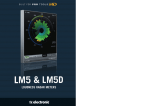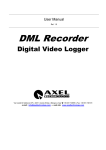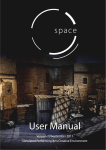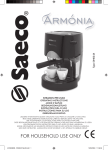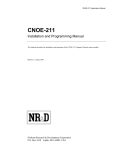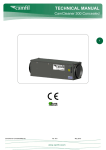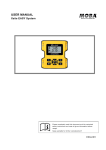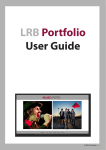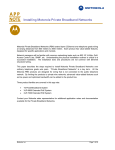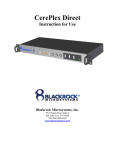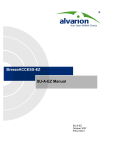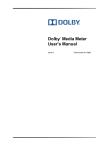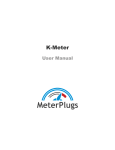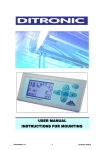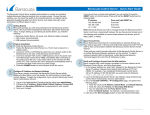Download LM6 Native manual
Transcript
LM6 Radar Loudness Meter USER’S MANUAL TC Support Interactive The TC Support Interactive website www.tcelectronic.com/support is designed as an online support and information center. At the site you can find answers to specific questions regarding TC software and hardware. All known issues are stored in a database searchable by product, category, keywords, or phrases. Under the section “My Stuff” you can login to check the status of your questions, download materials such as product manuals, software updates and new presets. This site has been specifically designed to meet the needs of our users. We constantly update the database and you will find the site to be a huge resource of information. Browse through Q&A’s and discover new aspects of your TC product. If you can’t find an answer online, you have the option of submitting a question to our technical support staff who will then reply to you by e-mail. The TC Support Team is on constant alert to help you in any way they can. www.tcelectronic.com © BY TC ELECTRONIC A/S 2012. ALL PRODUCT AND COMPANY NAMES ARE TRADEMARKS OF THEIR RESPECTIVE OWNERS. ALL SPECIFICATIONS SUBJECT TO CHANGE WITHOUT NOTICE.ALL RIGHTS RESERVED. TC ELECTRONIC IS A TC GROUP COMPANY. LM6 NATIVE Table of Contents Features.............................................................................. 4 System requirements............................................................ 4 Installation.......................................................................... 4 Introduction......................................................................... 6 Basic Use............................................................................ 8 Radar Page.......................................................................... 9 Long-term measurements...................................................... 9 Main page.......................................................................... 11 Descriptors........................................................................ 11 Loudness........................................................................... 14 Setup................................................................................ 16 Log................................................................................... 17 Level versus Loudness........................................................ 19 Post Script......................................................................... 22 LM6 - Radar Loudness Meter / 3 EN Table of Contents................................................................. 3 Features • • • • • • Realtime loudness meter adhering to ITU-R BS.1770-2 Loudness History Radar display. True-peak Bargraph display. Universal Descriptors Supports mono, stereo and 5.1. Presets for use in Broadcast, Music, Post and Film. System requirements Mac Intel CPU (we recommend at least 2 GHz) 2 GB RAM Mac OS 10.5 (Leopard) or higher Pro Tools 7.0 or higher or a VST/AU-compatible host PC Intel-compatible CPU (we recommend at least 2 GHz) 2 GB RAM Windows XP or higher Pro Tools 7.0 or higher or a VST-compatible host Formats Mac: VST2.4 32/64bit VST3 32/64bit Audio Units 32/64bit RTAS 32bit AAX Native 32bit Mac: VST2.4 32/64bit VST3 32/64bit Audio Units 32/64bit RTAS 32bit AAX Native 32bit Hosts LM6 supports all major hosts, including Pro Tools Logic Pro Final Cut Pro X Media Composer Nuendo Wavelab Istallation • Install iLok according to instructions found on www.ilok.com • Install LM6 Native following the instructions given in the installer 4 / LM6 Radar Loudness Meter - Loudness meter fully compliant with EBU R128 Loudness meter fully compliant with ATSC A/85 Loudness meter fully compliant with ITU-R BS.1770 Loudness meter fully compliant with ITU-R BS.1770-2 Radar meter showing Momentary and Short-term loudness True-peak bargraph meters Advanced Logging functionality LM6 - Radar Loudness Meter / 5 EN LM6 represents a quantum leap away from simply measuring audio level to measuring perceived loudness. The old level method is responsible for unacceptable level jumps in television, for music CDs getting increasingly distorted, and for different audio formats and program genres becoming incompatible: Pristine music tracks from the past don’t co-exist with new recordings, TV commercials don’t fit drama, classical music or film and broadcast doesn’t match. The most fundamental audio issue of all – control of loudness – every day makes millions of people adjust the volume control over and over again. LM6 is part of a universal and ITU standardized loudness control concept, whereby audio may easily and consistently be measured and controlled at various stages of production and distribution. LM6 works coherently together with other TC equipment, or with equipment of other brands adhering to the same global standard. Follow the guidelines given to allow audio produced for different purposes to be mixed, without low dynamic range material such as commercials or pop CD’s always emerging the loudest. Introduction Since 1998, TC has performed listening tests and evaluation of loudness models; and therefore holds an extensive, Universal Database of loudness, based on ten thousands of assessments. The database covers all sorts of broadcast material, music, commercials, feature film and experimental sounds, and is verified against other independent studies. Fig 1. Left: DRT for consumers under different listening situations Right: Peak level normalization means that material targeted low dynamic range platforms gets loud. The Universal Database is authoritative from an academic as well as a practical point of view. It has been indispensable when designing the LM6 meter, because it provided the missing link between short-term and long-term loudness, and enabled the statistically founded Universal Descriptors of LM6 . The chart of Dynamic Range Tolerance in Fig 1 is a side-effect of the studies mentioned: Consumers were found to have a distinct Dynamic Range Tolerance (DRT) specific to their listening environment. The DRT is defined as a Preferred Average window with a certain peak level Headroom above it. The average sound pressure level, which obviously is different from one listening condition to another, has to be kept within certain boundaries in order to maintain speech intelligibility, and to avoid music or effects from getting annoyingly loud or soft. Audio engineers instinctively target a certain DRT profile when mixing, but because level normalization in broadcast and music production is based on peak level 6 / LM6 Radar Loudness Meter LM6 offers a standardized option: The visualization of loudness history and DRT in combination with long-term descriptors from production onwards, is a transparent and well sounding alternative to our current peak level obsession. Not only for music, but also in production for broadcast or film. The engineer, who may not be an audio expert, should be able to identify and consciously work with loudness developments within the limits of a target distribution platform, and with predictable results when the program is transcoded to another platform. LM6 therefore color codes loudness so it’s easy to identify target level (green), below the noisefloor level (blue), or loud events (yellow), see Fig 2. Fig 2 Color coding and target loudness for selected broadcast platforms based on a consumer’s Dynamic Range Tolerance, DRT. The aim is to center dynamic range restriction around average loudness, in this case the –20 dB line, thereby automatically avoiding to wash out differences between foreground and background elements of a mix. Note how different the broadcast requirements are from those of Cinema. When production engineers realize the boundaries they should generally stay within, less dynamics processing is automatically needed during distribution, and the requirement for maintaining time-consuming meta-data at a broadcast station is minimized. In broadcast, the goal is to use the same loudness measure for: Production, Ingest, Linking, Master Control Processing and Logging - thereby ensuring better audio quality not only in DTV audio, but across all broadcast platforms. LM6 and TC processing can co-exist with PPM meters, VU meters or Dolby’s LM100 meter. LM6 greatly increases the usability of LM100 in production environments because it provides running status, and gives a standardized and intuitive indication of both dialog and non-dialog program. LM6 - Radar Loudness Meter / 7 EN measures, low dynamic range signatures end up the loudest as shown by the red line in Fig 1, right. Audio production is therefore trapped in a downwards spiral, going for ever decreasing dynamic range. By now, the pop music industry is “right of” In Flight Entertainment in the illustration. Basic Use LM6 makes use of a unique way of visualizing short-term loudness, loudness history, and long-term statistical descriptors. It may be used with mono, stereo and 5.1 material for any type of program material. Press the Radar key to bring up the Radar page. This page will be used most of the time. The basic functionality of the Radar page is shown in Fig 3. Fig 3 - Radar page features Target Loudness is displayed at 12 o’clock of the outer ring, and at the bold circle of the radar indicated also by the transition from green to yellow. The descriptors Loudness Range and Program Loudness, are the yellow numbers in the lower part of the display. Press the Reset key to reset Radar and Descriptors. Use Reset to clear all current meassurements and restart meter revolution from 12 o’clock position. The Pause function simply makes a temporary break in the metering an measumenst. Press the “Main” key to set basic setting such as Descriptor type, Loudness standard and Loudness units. Press the “Setup” key to access Radar page settings and path for Log file. Presets are handled via your host. 8 / LM6 Radar Loudness Meter Radar Page The outer ring of the Radar page displays Momentary loudness. The 0 LU point (i.e. Target Loudness) is at 12 o’clock, and marked by the border between green and yellow, while the Low Level point is marked by the border between green and blue. The LU Reference parameter are found on the Setup page. For instance, if 0 LU is set at -22 LUFS, and Low Level is set at -20 LU, the color coding of Fig 3 applies. You should keep the outer ring in the green area, and around 12 o’clock on the average. Excursions into the blue or the yellow area should be balanced, and not only go in one direction. The numbers associated with the outer ring may be referenced at either maximum loudness (LUFS selected), or have a zero point set at the 12 o’clock position (LU selected). Choose “LUFS” or “LU” at the Loudness Scale selection on the Main page depending on your preference. Either way of looking at loudness is valid. LUFS reading is in line with how peak level is typically measured in a digital system, and compatible with Dolby AC3 and E meta-data, while the LU approach calls for a certain target Loudness to have been predetermined, like e.g. a VU meter. Note how “LUFS” in some countries is called “LKFS”, but the two are identical. A reading of, for instance, -25.0 LUFS is precisely the same as -25.0 LKFS. Long-term measurements Universal descriptors may be used to make program-duration measurements, or you may “spot-check” regular dialog or individual scenes as required. It is recommended not to measure programs of a shorter duration than appoximately 10 seconds, while the maximum duration may be 24 hours or longer. Reset Key Before a new measurement, press the Reset key. This resets the descriptors, the radar and the true-peak meters. Run the audio, and watch the radar and descriptor fields update accordingly. It is normal that the descriptors wait five seconds into the program before showing the first readings, while the radar updates instantly. The first five seconds of a program are included in the descriptor calculations, even though they are not shown instantly. LM6 incorporates an intelligent gate, which discriminates between foreground and background material of a program. Consequently, a measure doesn’t start before audio has been identfied. It also pauses the measurement during periods of only background noise, and in the fade-out of a music track. Universal Descriptors and Dolby LM100 Unlike methods that measure dialog only, LM6 may be used with any type of audio – LM6 - Radar Loudness Meter / 9 EN Current Loudness: Outer Ring which includes dialog, of course. If you wish to measure dialog, it’s recommended to do a manual spot check of a program or a film. Find 10-30 seconds of regular dialog and measure it with LM6 . Where dialog may be soft, regular or loud, and shift by more than 15 dB inside a film, regular dialog tends to be less ambiguous and more consistent across a program. For compatibility with a proprietary measure such as Dolby LM100, only some of these meters are updated to use ITU-R BS.1770 and Leq(K) while others are locked at Leq(A). The software version of LM100 should be 1.3.1.5 or higher in order for it to comply with BS.1770, and to have its average loudness reading be compatible with Center of Gravity in LM5 or Program Loudness in LM6. Even used just on speech, Leq(A) is not a precise approximation to perceived loudness, so please update the unit to BS.1770 to obtain similar readings and predictable results. To measure dialog with LM6 the same way Dolby LM100 is sometimes used, solo the Center channel during a spot check to momentarily disable the channel weighting specified in BS.1770, if you’re working on a 5.1 stem. Universal Descriptors and AC3 Meta-data The “Dialnorm” parameter in AC3 meta-data should indicate the average loudness of a program. Basic dynamic range and level control that rely on this parameter may take place in the consumer’s receiver. Therefore, its value should not be far off target, or the consumer results become highly unpredictable. Program Loudness in LM6 is directly compatible with Dialnorm in AC3. Most broadcast stations work with a fixed dialnorm setting, for instance –23 LUFS. This would be the Program Loudness target level for any program. If your station is more music than speech, better inter- channel leveling may be obtained with dialnorm permanently set 1 or 2 LU lower than the Program Loudness target level. True-peak meters The peak meters of LM6 display true-peak as specified in ITU-R BS.1770. True-peak meters give a better indication of headroom and risk of distortion in dowstream equipment such as sample rate converters, data reduction systems and consumer electronics than digital sample meters used e.g. in CD mastering. Note that the standard level meters in most digital workstations and mixers are only sample peak (Final Cut, Avid, ProTools, Yamaha etc.), and should only be used as a rough guideline of the headroom. Note that the meter scale is extended above 0 dBFS. Most consumer equipment distorts if you see readings above 0. It’s not a problem to have true-peak level going to -1 dBFS in production, but legacy platforms (analog, NICAM etc.) and some data-reduction codecs may distort unless true-peak level is kept lower. With Dolby AC3 and with low bitrate codecs, -3 dBFS should be considered the limit, while legacy platforms requiring emphasis may need even further restriction. Like described in EBU R128, it’s recommended to make full use of the headroom with true-peaks going to -1 dBFS in production, and to only restrict peak level further during distribution/transmission. 10 / LM6 Radar Loudness Meter EN Main page Descriptors Descriptors 1 & 2 The two descriptors are displayed in lower left and right corners of the Radar page. The options for each the descriptors are: -Range - Program Loudness - Sliding Loudness - Loudness Max -Off Range Loudness Range, standardized in EBU R128 and abbreviated “LRA”, displays the loudness range of a program, a film or a music track. The unit is LU, which can be thought of as “dB on the average”. LM6 - Radar Loudness Meter / 11 The Loudness Range descriptor quantifies the variation of the loudness measurement of a program. It is based on the statistical distribution of loudness within a program, thereby excluding the extremes. Thus, for example, a single gunshot is not able to bias the LRA number. EBU R128 does not specify a maximum permitted LRA. R128 does, however, strongly encourage the use of LRA to determine if dynamic treatment of an audio signal is needed and to match the signal with the requirements of a particular transmission channel or platform. Consequently, if a program has LRA measured at 10 LU, you would need to move the master fader +- 5 dB to make loudness stay generally the same over the duration of the program. (Not that you would want that). In production, Loudness Range may serve as a guide to how well balancing has been performed, and if too much or too little compression has been applied. If a journalist or video editor isn’t capable of arriving at a suitable LRA, he could be instructed to call an audio expert for help. This may be regarded as initial production guidelines: HDTV and digital radio: Stay below LRA of 20 LU. SDTV: Stay below LRA of 12 LU. Mobile TV and car radio: Stay below LRA of 8 LU. Remember to use LRA the other way around too: If there is an ideal for a certain genre, check its LRA measure, and don’t try go below it. LRA should not be used for Limbo. Allow programs or music tracks the loudness range they need, but not more than they need. Loudness Range may also be measured on a broadcast server to predict if a program is suitable for broadcast without further processing. LRA is even a fingerprint of a program and stays the same downstream of production if no dynamics processing has been applied. You may even check the number out of a consumer’s set-top box to verify that distribution processing and Dolby DRC has been disabled. Like with Program Loudness and Loudness Max, the meter should be reset before measuring LRA. Prog. Loudn. Program Loudness returns one loudness number for an entire program, film or music track. Its unit is LUFS. Some vendors and countries use the unit “LKFS” or “LUFS”, but they are identical: An absolute measure of loudness in the digital domain, where the region around “0” is overly loud and not relevant for measuring anything but test signals. Expect readings of broadcast programs in the range between -28 and -20 LUFS. Program Loudness is used as a production guideline, for transparent normalizing of programs and commercials, and to set loudness meta-data in delivery if so required. For delivery or transmission of AC3 format, the meta-data parameter “dialnorm” should reflect Program Loudness. The easiest way to handle multiple broadcast platforms is to normalize programs at the station to a certain value, thereby being 12 / LM6 Radar Loudness Meter Loudness measurements in LM6 are all rooted in ITU-R BS.1770. However, subtle differences exist between different regions of the world. Therefore LM6 also includes the “Loudness Standard” parameter. Be sure to set this parameter correctly for compliance in your region. The Program Loudness target is more or less the same for broadcasters around the world, especially when taking the measurement differences into account. Target numbers range between -24 and -22 LUFS. Like with Loudness Range and Loudness Max, the meter should be reset before measuring Program Loudness. Sliding Loudn. Sliding Loudness, unlike Program Loudness, Loudness Range and Loudness Max, is a continuously updated measure that doesn’t need to be reset. This type of descriptor is especially useful when “mixing by numbers”, i.e. when there is no access to the extremely informative radar display. When mixing by numbers, having Program Loudness as one descriptor and Sliding Loudness as the other displays simultaneous information about the full program side by side with the most recent loudness history. Note 1: Because the Sliding Loudness measurement is completely un-gated, it may also be used to spot check sections of a program complying to “raw” ITU-R BS.1770 and the first revision of ATSC A/85. Note 2: LM6 makes use of optimized statistics processing in order to display a sliding loudness value (a prognosis) as quickly as possible after a reset. Loudness Max Loudness Max displays the maximum loudness registered since the meter was last reset. Loudness Max is an especially useful parameter when checking and normalizing short duration programs such as promos and commercials. BCAP rules from the UK is an example of using Loudness Max as an efficient instrument to reduce listener complaints regarding loud commercials. While Program Loudness is adequate to normalize a consistent mix, Loudness Max may be used as a second line of transparent defense against overly short and loud event. Off Nothing is displayed. Sliding Ldn Time Options: 3 sec, 6 sec , 10 sec , 15 sec 30 sec, 1 min, 2 min, 4 min, 8 min When Sliding Loudness is selected in Descriptors 1 or 2, this parameter sets the window for analysis. E.g. if 6 seconds is selected the loudness range for the past 6 seconds is displayed. LM6 - Radar Loudness Meter / 13 EN able to take advantage of the normalization benefits across platforms, at the same time enabling static meta-data. Max Ldn Time Options: 0.4 sec, 3 sec, 4 sec, 5 sec, or 10 sec When Loudness Max is selected in Descriptors 1 or 2, this parameter sets the window for analysis. E.g. if 3 seconds is selected the Max Loudness for the past 6 seconds is displayed. Loudness Loudness Std. Options: BS.1770-2, Leq(K) or Cnt of Grav. The Program Loudness measure is always rooted in the ITU-R BS.1770 loudness model. This parameter sets measurement gating. Note that the parameter only influences Program Loudness, and not Sliding Loudness or Loudness Max. BS.1770-2 This setting reflects the latest revision of ITU-R BS.1770. Relative gate at -10 LU, safety gate at -70 LUFS. Leq(K) This setting reflects the original version of ITU-R BS.1770. No measurement gate besides from at safety gate at -70 LUFS, so the user doesn’t need to precisely start and stop a measurement in order to avoid bias from complete silence. Cnt of Grav. The standard setting from early versions of TC radar meters. Relative gate at -20 LU, safety gate at -70 LUFS. LU Reference Range: -36 LUFS to -6 LUFS The parameter specifies the loudness level to generally aim at. It affects a number of functions and displays in LM6, and must be set according to the standard you need to comply with. Current broadcast standards require Target to be in the range between -26 and -20 LUFS. For instance, EBU R128 calls for -23 LUFS while ATSC A/85 specifies -24 LUFS. The LU Reference parameter affects these LM6 functions and displays: 1. LU Reference sets the reference point for loudness measurements in LU. If the Loudness Unit parameter is set to LU, Program Loudness, Sliding Loudness and Loudness Max will be shown in LU relative to LU Reference. Meassurements that a on precisely on target will consequently read “0.0 LU”. 2. LU Reference defines the “12 o’clock” value of the Radar meter. 14 / LM6 Radar Loudness Meter LUFS All measurements of program loudness and sliding loudness are shown in units of LUFS, that is, in Loudness Units on the absolute scale. This is the normal setting for the Loudness Unit parameter, that we recommend for most applications. Loudness Range is always shown in units of LU, because it is basically a measurement of ‘range’ or of the distance between a high and a low loudness level. LU In this setting, measurements of program loudness and sliding loudness are shown in units of LU, that is, in Loudness Units on a relative scale. The 0 LU is by definition the target loudness level, such as -23.0 LUFS. So by selecting ‘LU’, one can immediately see if a loudness level is above the target level (e.g. +1.2 LU) or below (e.g. -3.4 LU). LM6 - Radar Loudness Meter / 15 EN Loudness Unit Setup Momentary Range EBU +9 or EBU +18 Set range on the radar-meter EBU mode meters are able to display to show two different momentary displays: One with a narrow loudness range intended for normal broadcast and denoted “EBU +9”, and one with a wide loudness range intended for film, drama and wide range music denoted “EBU +18”. The “EBU +9” setting gives a momentary meter range from -18 to +9 LU, while the “EBU +18” settings gives a momentary range from -36 to 18 LU. Radar Speed Radar Speed controls how long time each radar revolution takes. Select from 1 minute to 24 hours. You may “zoom” between the settings, as long as the history isn’t reset. Pressing the Reset key resets the meter and descriptor history. Radar Resolution Radar Resolution sets the difference in loudness between each concentric circle in the Radar between 3 and 12 dB. Choose low numbers when targeting a platform with a low dynamic range tolerance. You may “zoom” between the settings, as long as the history isn’t reset. 16 / LM6 Radar Loudness Meter Low Level Below EN Low Level Below determines where the shift between green and blue happens in the outer ring. It indicates to the engineer that level is now at risk of being below the noise floor. Peak Indicator Range: -3 to +12 dBFS With the Peak indicator you set at which level the red peak indicator in the top of the meters is invoked. Show PPM Options: On/Off If you use the Radar page as standard you may find the flickering meters visually disturbing. This option allows you to turn the PPM meters on/off. Auto Pause On/Off - When ‘on’, meassuring will follow the host and meassure only while the host is running. Note: Not all hosts supports the LM6’s Auto Pause function. If LM6 is inserted in a host that does not supprt the Auto pause function the option is greyed out. Loudness Unit Name Choose between LKFS and LUFS depending on preference and region. LKFS is typically used in USA and LUFS is typically used in Europe. LKFS refers to loudness units on an absolute scale and is equal to LUFS. Log A new Log file is created every time the plug-in is opened. The Log file includes information such as: - when LM6 was opened - how long LM6 time LM6 measured material since it was opened last - Loudness Range and Program loudness data since last time LM6 was opened The log file is saved in the path set under Log File Folder. To set the log file folder. Double-click in the log File Folder field and navigate using the computers Finder/ Explorer Reveal Press Reveal to navigate directly to the filder specified in the Log File Folder field. LM6 - Radar Loudness Meter / 17 Stats Page The Stats page gives an overview of essential descriptors. Note! The Reset button resets the meters and the log file. 18 / LM6 Radar Loudness Meter Level versus Loudness Quasi-peak level meters have this effect. They tell little about loudness, and also require a headroom in order to stay clear of distortion. Using IEC 268-18 meters, the headroom needed is typically 8-9 dB. Sample based meters are also widely used, but tell even less about loudness. Max sample detection is the general rule in digital mixers and DAWs. The side effect of using such a simplistic measure has become clear over the last decade, and CD music production stands as a monument over its deficiency. In numerous TC papers, it has been demonstrated how sample based peak meters require a headroom of at least 3 dB in order to prevent distortion and listener fatigue. The only type of standard level instrument that does not display some sort of peak level is the VU meter. Though developed for another era, this kind of meter is arguably better at presenting an audio segment’s center of gravity. However, a VU meter is not perceptually optimized, or ideal for looking at audio with markedly different dynamic range signatures. Unlike electrical level, loudness is subjective, and listeners weigh its most important factors - SPL, Frequency contents and Duration - differently. In search of an “objective” loudness measure, a certain Between Listener Variability (BLV) and Within Listener Variability (WLV) must be accepted, meaning that even loudness assessments by the same person are only consistent to some extent, and depends on the time of day, her mood etc. BLV adds further to the blur, when sex, culture, age etc. are introduced as variables. Because of the variations, a generic loudness measure is only meaningful when it is based on large subjective reference tests and solid statistics. Together with McGill University in Montreal, TC Electronic has undertaken extensive loudness model investigation and evaluation. The results denounce a couple of Leq measures, namely A and M weighted, as generic loudness measures. In fact, a quasi-peak meter showed better judgement of loudness than Leq(A) or Leq(M). Even used just for speech, Leq(A) is a poor pick, and it performs worse on music and effects. An appropriate choice for a low complexity, generic measurement algorithm, which works for listening levels used domestically, has been known as Leq(RLB). Combined loudness and peak level meters exist already, for instance the ones from Dorroughs, but BS.1770 now offers a standardized way of measuring these parameters. In 2006, ITU-R Working Party 6J drafted a new loudness and peak level measure, BS.1770, and the standard has subsequently come into effect. It has been debated if the loudness part is robust enough, because it will obviously get exploited where possible. However, with a variety of program material, Leq(RLB) has been verified LM6 - Radar Loudness Meter / 19 EN When level normalization in audio distribution is based on a peak level measure, it favors low dynamic range signatures as shown in Fig 1. This is what has happened to CD. in independent studies to be a relatively accurate measure, and correlate well with human test panels. It therefore seems justified to use Leq(RLB) as a baseline measure for loudness, especially because room for improvement is also built into the standard. The final BS.1770 standard included a multichannel annex with a revised weighting filter, R2LB – now known as “K” weighting - and a channel weighting scheme. These two later additions have been less verified than the basic Leq(RLB) frequency weighting. The other aspect of BS.1770, the algorithm to measure true-peak, is built on solid ground. Inconsistent peak meter readings, unexpected overloads, distortion in data reduced delivery and conversion etc. has been extensively described, so in liaison with AES SC-02-01, an over-sampled true-peak level measure was included with BS.1770. In conclusion, BS.1770 is an honorable attempt at specifying loudness and peak level separately, instead of the simplistic (sample peak) and mixed up measures (quasi-peak) in use today. The loudness and peak level measurement engine of LM6 follows the standard precisely. Possible updates to the ITU standard may be released as LM6 updates, provided that processing requirments doesn’t exhaust the system. Technical papers from AES, SMPTE, NAB and DAFX conferences with more information about loudness measurement, evaluation of loudness models, true-peak detection, consequences of 0 dBFS+ signals etc., are available from the TC website. Visit the Tech Library at www.tcelectronic.com/techlibrary.asp for details. Meter Calibration Because of the frequency and channel weighting, and of the way channels sum, only specific tones and input channels should be used for calibration. The most transparent results are obtained using a 1 kHz sine tone for calibration. Other frequencies or types of signal may be used (square wave, noise etc.), but don’t expect similar results. The beauty of the system lies in its RMS foundation, so this is a feature, not an error. The same feature enables the loudness measure to identify overly hot CDs or commercials, and to take out of phase signals into account just as much as signals that are in phase. If we stick to standard methods for measuring peak audio level in a digital system, where a sine wave (asynchronous of the sample rate) with digital peaks at 0 dBFS, is regarded a 0 dBFS tone, BS.1770 and LM6 output these results: One front channel fed with a –20 dBFS, 1 kHz sine tone => Reading of –23,0 LUFS. Two front channels fed with a –20 dBFS, 1 kHz sine tone => Reading of –20,0 LUFS. All 5.1 channels fed with a –20 dBFS, 1 kHz sine tone => Reading of –15,4 LUFS. 20 / LM6 Radar Loudness Meter LM6 may use either the measurement unit of LU (Loudness Units) or LUFS (Loudness Units Full Scale). LU and LUFS are measurements in dB, reflecting the estimated gain offset to arrive at a certain Reference Loudness (LU) or Maximum Loudness (LUFS) as defined in BS.1770. Since a common reference point for LU has not been agreed on at the time of writing, LUFS (or “LKFS”, pointing specifically to the Leq(R2LB) weighting of BS.1770), might be favored initially to avoid ambiguous use of the term LU. The effectiveness of any loudness meter depends on both the graphical appearance and dynamic behavior of its display, as well as on its underlying measurement algorithms. A short-term loudness meter also relies on the measurement algorithm’s ability to output pertinent loudness information using different analysis windows, for instance, 200-800 ms for running realtime updates. It should be noted how the optimum size of this window varies from study to study, possibly because the objective of a running display hasn’t been fully agreed upon. Formal evaluation of a visualization system is challenging: First of all, one or more metrics must be defined by which the display should be evaluated. The correspondence between the sound heard and the picture seen is one aspect to be evaluated. Another metric could characterize the speed of reading the meter reliably. In TC Electronic LM2, LM5 and LM6, short-term, mid-term and long-term of loudness measurements are tied together coherently, and displayed in novel ways (angular reading and radar) that were preferred in its development and test phases. However, we remain open to suggestions for further improvement of the visualization of loudness. LM6 - Radar Loudness Meter / 21 EN Display Post Script Control of loudness is the only audio issue that has made It to the political agenda. Political regulation is currently being put into effect in Europe to prevent hearing damage and disturbances from PA systems, and to avoid annoying level jumps during commercial breaks in television. In Australia, something similar may happen. Many years of research into loudness of not only dialog, but also of loudness relating to any type of audio programming, has brought TC to the forefront of companies in the world to perform realtime loudness measurement and control. Therefore, TC has taken active part in loudness standardization efforts in Japan, the United States, Europe and other areas. In broadcast, digitization is driving the number of AV channels and platforms up, while the total number of viewers remains roughly the same. On the sound production side, it is therefore important that delivery criteria can be easily specified and met, even by people not primarily concerned with audio: Journalists, musicians, video editors, marketing professionals etc. Using only dialog based audio measurements in digital broadcast, has led to ambiguous level management, more level jumps between programs, and extra time spent on audio production and management in general. Non-dialog based level jumps are currently creating havoc in digital TV, and LM6 helps correct that situation. The LM6 Loudness Meter can be used to control level and improve sound, not only in Dolby AC3 based transmissions, but also on other broadcast platforms, such as analog TV, mobile TV and IPTV. To summarize: LM6 is part of a holistic and universal approach to loudness control, starting at the production or live engineer. When she realizes the dynamic range at her disposal, less processing is needed at later stages of a distribution chain. The chain ends with the capability of quality controlling everything upstream by applying the same loudness measure for logging purposes: A closed loop. Welcome to a new, standardized world of audio leveling. Across genres, across formats, across the globe. 22 / LM6 Radar Loudness Meter
























